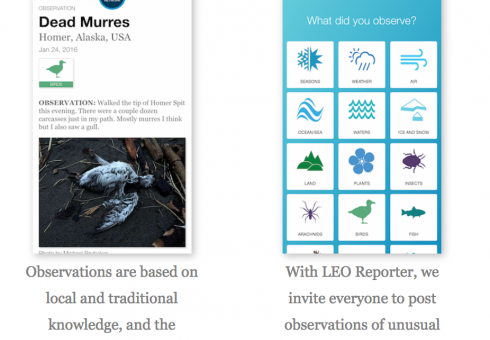Sink Holes, Dying Birch, and a Spring Cold Snap: Supporting Local Observations on Environmental Change with Indigenous and Scientific Knowledge

What do sink hole damages at the Inuvik airport, dying birch in Yellowknife, and a spring cold snap in Whitehorse have in common? They are all unusual local observations submitted to the Local Environmental Observer Network (LEO) website that could be indicators of a changing climate.
The LEO is a unique platform for recording observations of unusual changes in plants, animals and the environment. Local observers are connected with a network of local and national experts. For example, the Lands Specialist at Kwanlin Dun First Nation in Yellowknife recorded his observation of unusually low temperatures they experienced in March in right on the tails of fine spring weather. “The new normal is topsy turvy” he noted in his post. Almost immediately, a researcher at the University of Victoria provided him with a graph that showed 30 years of data that he could use for comparison.
Members can share observations and collaborate with topic experts who bring indigenous and Western scientific forms of knowledge. The purpose of the Network is to increase understanding of environmental change and to help identify healthy and effective ways to adapt to those changes.
The LEO Network began in native tribal Alaskan communities and is starting to broaden rapidly in Canada. The LEO Network is being implemented in British Columbia through a partnership between the First Nations Health Authority, the Commission for Environmental Cooperation, the Alaska Native Tribal Health Consortium, and Ocean Integrity Research as a way to better understand environmental changes that are being observed in BC. LEO is open to anyone who wishes to join and share solutions for adapting to our ever-changing environment. Indigenous Guardians, environmental managers, and natural resource staff can participate in all capacities of the network, as they see appropriate.
Participation can be as simple as sharing an observation or a link to a news article about an unusual environmental change, but the platform can also be tailored to particular themes, projects, or interests of a community. To participate, the first step is to register a profile either as an individual or an organization, and then it’s easy to post an observation of an unusual event or an observed long-term change.
A core strength of the LEO platform is how it can be used as a tool for narrative storytelling – qualitative observations of environmental change. Observations are submitted through the website or a mobile app called LEO Reporter, and can include descriptions, photos, video, and audio information. It is a useful way to document changes and share them with others to begin to see emerging trends. Communities can decide what information to post and share with the Network, and the level of detail. Maps are interactive and a search engine allows users to easily explore other observations. LEO was built by and for indigenous people, but it is open to everyone for cross-cultural and collaborative knowledge sharing.
Have you witnessed an unusual change in the weather, seasons, plants or animals? Share them on LEO and help us understand our changing world. Learn more about the LEO Network or email the LEO BC Hub Coordinator: Tom Okey, Ocean Integrity Research [email protected].